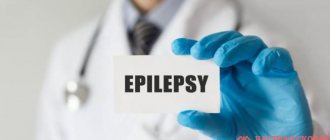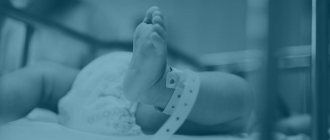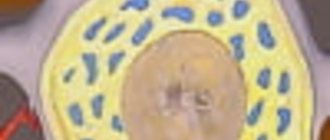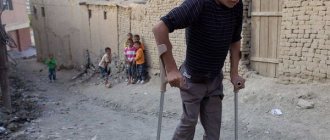what is episyndrome
Episyndrome is sudden and recurring attacks of convulsions in a child, externally similar to epilepsy.
Episyndrome is always a consequence of some disease. The attacks stop as soon as the underlying cause of which they were a symptom is cured.
If for the development of an attack of true epilepsy an epileptic focus is needed (a group of brain cells with increased electrical activity), then with episyndrome there is no such focus, therefore, when examined on an electroencephalogram (EEG), it is not found.
Factors that provoke epilepsy attacks
Lack of sleep or interrupted sleep. The body seems to be trying to make up for lost REM sleep, as a result of which the electrical activity of the brain changes and an attack may begin.
Stress and anxiety can contribute to attacks.
Medicines that stimulate the central nervous system (Ceraxon, Cerebrolysin) can cause an attack of epilepsy, as well as an increase in the dose of insulin due to hypoglycemia.
Any serious illness, such as pneumonia, can contribute to an attack.
An attack can also be triggered by flashing bright light, for example, when watching cartoons. There is so-called television epilepsy - this is a special state of photosensitivity, which is based on the movement of spots that make up the picture. Sensitive children may react to watching TV with an attack.
If your child has epiactivity on the EEG, but there are no seizures, then you need to keep in mind that under any stress factors, be it illness or hormonal changes, they may appear. And once you enter stable remission, you need to be prepared.
causes and symptoms of episyndrome
The main cause of episyndrome is oxygen starvation of brain cells, as well as changes in their chemical state.
Such processes develop as a result of birth injuries of the cervical spine, causing a decrease in cerebral blood flow and an increase in intracranial pressure, as well as after various brain injuries (trauma, previous diseases, chemical poisoning).
The development of seizures occurs from irritation of the cerebral cortex or its deep structures and is accompanied by a flash of increased electrical activity of nerve cells (a kind of “short circuit” in the brain).
Quite often, the first attack of seizures in a child develops at elevated temperatures or after vaccination, since in such conditions intracranial pressure increases and oxygen starvation of brain cells increases.
More rare causes of episyndrome are tumors, cysts, parasites, infectious processes of the brain, toxic poisoning, underdevelopment of the brain in cerebral palsy, metabolic disorders.
Externally, an attack of episyndrome is manifested by a sudden increase in tone in the limbs, muscle spasms and twitching both in sleep and while awake, trembling of the limbs, tics, nods, rocking movements of the torso, freezing, rolling of the eyes, twisting of the torso, and cessation of breathing. These attacks are usually not accompanied by loss of consciousness.
Symptoms of manifestation
Those experiencing epilepsy for the first time can be quite shocked. Indeed, in most cases, attacks look frightening and are accompanied by the following symptoms:
- There is a blackout of consciousness. The child may play, smile or even cry, but then he suddenly becomes quiet.
- During an epileptic attack, infants may have seizures. Arms and legs may bend unnaturally, and the small body may shake violently. The muscles spasm and become hard. Cramps may involve the entire body, only one part of the body, only one limb, or be absent altogether.
- The eyes roll behind the eyelids.
- Changes in breathing are observed. The baby may begin to breathe too quickly and noisily. Or, on the contrary, his breathing slows down, it seems that the child is not breathing.
- The pupils are dilated and do not respond to changes in light.
However, not all forms of epilepsy are accompanied by such symptoms. Often the signs of epilepsy in infants are almost invisible, so sometimes parents do not pay due attention to them. But as soon as the baby’s behavior changes, you need to contact a specialist.
There is also a so-called aura or precursors to epilepsy. They appear about a day before the attack. The baby becomes capricious, constantly cries, and refuses to eat.
Minor seizures
In this case, epileptic foci spread only to part of the brain. Petite seizures include the following types of epilepsy:
- Propulsive seizure. Most often it is a consequence of birth trauma. During such a seizure, the baby bends his head and torso. The attack lasts only a few seconds. However, several repetitions per day may occur.
- Retropulsive. The baby loses consciousness. His eyes close, and his body remains in the same position it was in. It seems that the child just fell asleep.
- Impulsive attack. How to determine such epilepsy in an infant? The baby remains conscious. However, from time to time one or another part of the body trembles, as impulses are sent to it from the brain.
Minor seizures can occur even during sleep. If epilepsy is accompanied by seizures, you need to ensure that the baby sleeps only in the crib. There should be no hard objects near it that it could hit.
Generalized
Symptoms of epilepsy in infants can be very pronounced. This happens with a generalized or grand mal seizure. The whole body is attacked by convulsions, the baby bends, his legs and arms can perform sudden chaotic movements. The face turns pale, foam comes out of the mouth, and involuntary bowel movements are possible.
The danger of such an attack is that the baby may hit himself due to severe convulsions. Teething babies may bite their tongues hard. This can lead to large blood losses. To avoid this, during an attack the baby should be placed on a soft pillow, and a special device for biting should be placed in his mouth.
debunking myths about episyndrome
Today, there are a number of misconceptions about the problem of episyndrome, generated mainly by the lack of objective information among parents who are faced with this problem about the causes of episyndrome and the proposed treatment. We will try to clarify this issue and debunk the most popular myths.
Cramps at high temperatures are not a deviation
With normal functioning of the brain, even at high temperatures, seizures do not develop. Convulsions against a background of high temperature indicate a malfunction of the central nervous system.
Seizures indicate the presence of epilepsy
Epilepsy always manifests itself in different types of seizures, but not all seizures indicate the presence of epilepsy. In particular, with episyndrome, seizures develop against the background of oxygen starvation of brain cells.
Seizure attacks are treated with anticonvulsants
Anticonvulsants are used in the presence of an epileptic focus in the brain. In episyndrome, this focus is absent and the drugs do not have the expected effect - the frequency of seizures does not decrease, and sometimes even increases.
Seizures are hereditary
Most seizures are not associated with heredity, but indicate a violation of brain activity. It is extremely rare that attacks can be traced across several generations of relatives.
Seizure attacks are incurable and require lifelong medication
Only a rare hereditary form of epilepsy, in which seizures occur throughout life and the patient is prescribed symptomatic treatment with anticonvulsants, cannot be treated. Other forms of epilepsy and episyndrome are effectively treated. In each case, it is necessary to select individual treatment depending on the cause of seizures.
As can be seen from the examples described above, an objective look at the problem of episyndrome from the point of view of the causes of its occurrence and methods of solution helps the parents of a child who has been diagnosed with this disease to promptly and thoughtfully approach the choice of an effective and safe treatment method.
Classification of focal epilepsy
There are symptomatic, idiopathic and cryptogenic forms of focal epilepsy. In the symptomatic form, it is possible to establish the source and cause of the pathology, as well as identify morphological changes that are recorded during tomographic studies.
A feature of cryptogenic PE is that, despite its secondary nature, none of the existing imaging methods is capable of identifying morphological abnormalities in the structure of the brain.
Idiopathic PE is not characterized by brain defects typical for this group of pathologies. The substrate for its development, as a rule, is a hereditary predisposition: genetically determined channelopathies, defects in the membranes of CNS cells, dysgenesis of the cerebral cortex. The prognosis for this disease is favorable, the course is benign. Idiopathic FE includes: benign rolandic epilepsy, childhood occipital Gastaut epilepsy, Panagiotopoulos syndrome, benign occipital epileptic syndromes.
about our treatment of episyndrome
If a child’s electroencephalogram (EEG) examination does not reveal an epileptic focus, then we do not see the need to prescribe anticonvulsants. When using such drugs, there is no improvement, since the cause of the development of seizures is different.
For the treatment of episyndrome, we offer an effective and safe method of traction therapy aimed at restoring cerebral blood flow and reducing intracranial pressure, as a result of which the main cause of episyndrome is eliminated - oxygen starvation of brain cells
Treatment is carried out on an outpatient basis (outside the hospital) and involves the child wearing a traction collar of an original design (
) in combination with taking natural medications to normalize brain activity.
Our treatment quickly and effectively solves the problem of episyndrome, while it is safe and reliable.
The first effects are felt within a few days from the start of treatment: the child’s well-being improves significantly, the frequency of attacks decreases and soon they stop completely
Maximum effectiveness is achieved thanks to a fundamentally different approach to solving the problem of episyndrome - our treatment is aimed at eliminating the cause, rather than suppressing the symptoms of the disease
The treatment we offer is completely safe, since the traction collar does not have a negative effect on the child’s body, and the prescribed drugs do not cause complications or side effects
After the course of treatment, seizures no longer occur, since during treatment the main cause of the disease is eliminated and the natural functions of the brain are restored
Thus, the traction therapy we offer, due to its obvious advantages, is an excellent and often the only alternative not only to taking anticonvulsants, but also to other methods of treating episyndrome.
EEG
EEG is used to detect epileptic activity in an individual. There are many types of seizures, each with characteristic behavioral changes and electrophysiological abnormalities. They can usually be detected in scalp electroencephalographic recordings (EEG).
If the child has a single attack and no abnormalities were detected during the EEG examination, then treatment is not prescribed. Such a child only needs the supervision of specialists, since medications when used have side effects.
The selection of anticonvulsant medications is prescribed in case of detection of changes in the functioning of the brain, detection of chronic diseases and tumors that cause seizures.
Our clinic specialists perform EEG examinations on children under three years of age.










